A Private Tour today in the Norfolk Broads. Although many of the wintering birds have now departed, and the summer breeders have yet to arrive, there are still plenty of things to see on a day out in the Broads, and some fantastic scenery to enjoy.
 Peacock – greeting your arrival at NWT Hickling Broad
Peacock – greeting your arrival at NWT Hickling Broad
Our first stop of the day was the NWT reserve at Hickling Broad, once we had negotiated our way past the Peacock on the entrance track.! We met in the car park and set off down the track behind the visitor centre. There were a few geese on the grazing meadows, Greylags and Canada Geese, with a pair of Tufted Duck on the water and a lone female Pochard standing on the bank nearby. We were just scanning the reedbed when we heard a Common Crane call and turned round to see two flying towards us from the direction of the Broad.
 Common Crane – two flew overhead this morning
Common Crane – two flew overhead this morning
It was as if they felt the need to announce their imminent arrival to us, as they did not call again once we had seen them. The two Cranes flew slowly past, head and legs outstretched fore and aft, and disappeared off towards Stubb Mill. It was a great way to start the day.
As we approached Bittern Hide we could hear Marsh Harriers calling. We had already seen several on the way there, and we sat in the hide and watched more of them flying back and forth over the reeds. A pair at the back engaged in a short bout of talon-grappling. There didn’t seem to be much else in front of the hide at first, but when a Common Snipe dropped into the cut reeds along the side, a closer look revealed a Water Pipit creeping back into the vegetation.
At first, we could just make it out through the scope. It was preening and it had its back to us. But then the Water Pipit walked back to the water’s edge and came out into full view. At this point we could see that it was moulting into summer plumage, mostly now lacking streaking on its underparts and with a delicate pink flush across its breast instead. It picked around on the little patches of exposed mud for a couple of minutes before something spooked it. As it flew off calling, a second Water Pipit came up from the cut reeds to follow it.
 Water Pipit – moulting into summer plumage
Water Pipit – moulting into summer plumage
 Water Pipit – its breast now mostly unstreaked and washed with pink
Water Pipit – its breast now mostly unstreaked and washed with pink
We took our leave and continued on, round towards the edge of the Broad. A male Marsh Harrier was calling high overhead and we watched it start to display, tumbling and swooping, gradually losing height until it dropped down into the reeds. A second Marsh Harrier, a young male, started to display nearby and the next thing we knew three were circling up together calling. The sun had just broken through the clouds and there as a bit of warmth in the air, just enough to get them all going.
Hickling Broad itself appeared fairly quiet at first, but we stopped at the screen for a closer look. A small group of Common Pochard were preening along the edge of the reeds, including three smart drakes. Further out, a Great Crested Grebe was swimming in amongst a small group of Coot. We were just looking at the Grebe when we spotted a different duck further back still and through the scope we could see it was a Common Scoter. More normally found out on the sea, this was a bit of a surprise out here but they do occasionally wander inland.
We made our way back round to the car park and drove on. Just out of the village, we heard Redwings call as they flew out of the hedge beside the road. A little further on, we could see into the field beyond and the short-cropped grass eaten down by the sheep was covered in Redwings and Fieldfares. There have been good numbers of Fieldfares particularly around here all winter, but our winter thrushes are now getting ready to fly back to the continent and feeding up near the coast.
The drive around the coast road south from Sea Palling was rather quiet today. Gone are most of the winter geese, though we did manage to find a couple of Pink-footed Geese still. One of them looked to be injured, with a drooping wing, which might explain why it was still here. There was still some standing water in the fields the other side and a little flock of Dunlin was flying round between the patches of exposed mud. The Golden Plover further over were hunkered down and looked to all intents and purposes like clods of earth themselves. We meandered our way round, with no sign of more Cranes in any of the fields where we have seen regularly them over the winter.
Our next destination was Filby Broad. We had just walked across the road to start scanning the open water when we noticed a large bird fly up across the road ahead of us. This was then followed by a second and then a third. They were White Storks and normally the sight of three White Storks circling up into the sky would be a source of much excitement. However, these are free flying birds from a local wildfowl collection which are often seen around the area here.
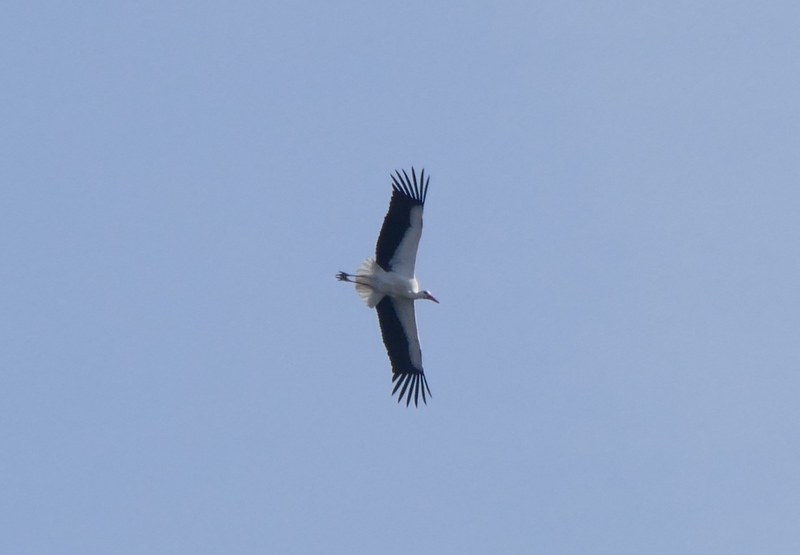 White Stork – a free flying bird from the local wildfowl collection
White Stork – a free flying bird from the local wildfowl collection
We turned our attention back to the Broad and started to scan the water from the boardwalk. There were quite a few Tufted Duck and a handful of Goldeneye out on the water, as well as lots of gulls and Coots. Working our way through them all methodically, we managed to find the Red-necked Grebe which has been here now for some time. It was a long way over, but through the scope we could see that it was starting to come into summer plumage, looking very bright now with white cheeks and a rusty red foreneck and breast.
 Red-necked Grebe – looking smart in summer plumage, though rather distant
Red-necked Grebe – looking smart in summer plumage, though rather distant
The Great Crested Grebes were much more obliging. There were several pairs out on the Broad and one swam right past in front of us. They too are looking stunning in their summer plumage now. A Kingfisher kept zooming back and forth from one edge of the Broad to the other, flashing electric blue as it went.
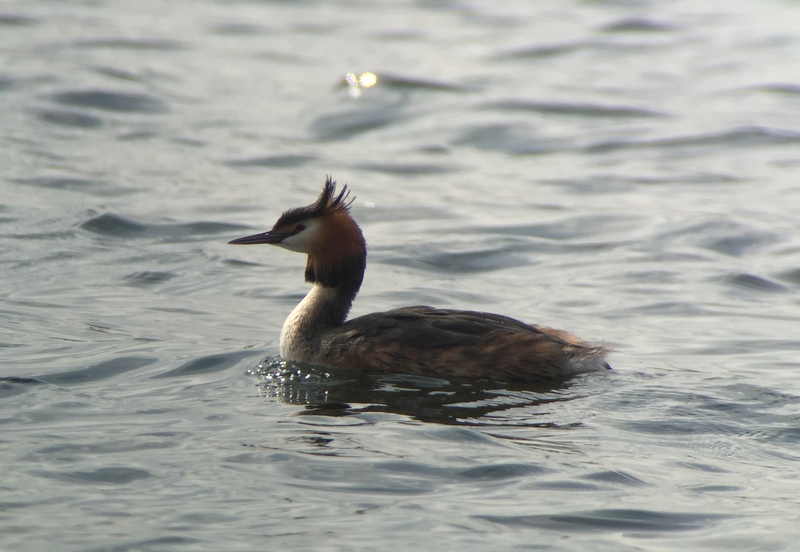 Great Crested Grebe – there are always lots on the Broads
Great Crested Grebe – there are always lots on the Broads
With our key target here achieved, we made our way on to Strumpshaw Fen next. There are not so many ducks on the pool in front of Reception Hide now, although still a nice selection of Gadwall, Teal, Mallard and Shoveler.
 Shoveler – a nice selection of ducks was visible from Reception Hide
Shoveler – a nice selection of ducks was visible from Reception Hide
By this stage of the day, the cloud had thickened again and it was rather cool and grey. As a consequence, the walk out to Fen Hide was rather quiet. We did hear a Water Rail squeal from the reeds and several Cetti’s Warblers shouting at each other. There has been a Jack Snipe seen from the hide on and off in recent weeks and we had hoped we might be able to find it today. It was not to be and all we could locate here were two Common Snipe instead.
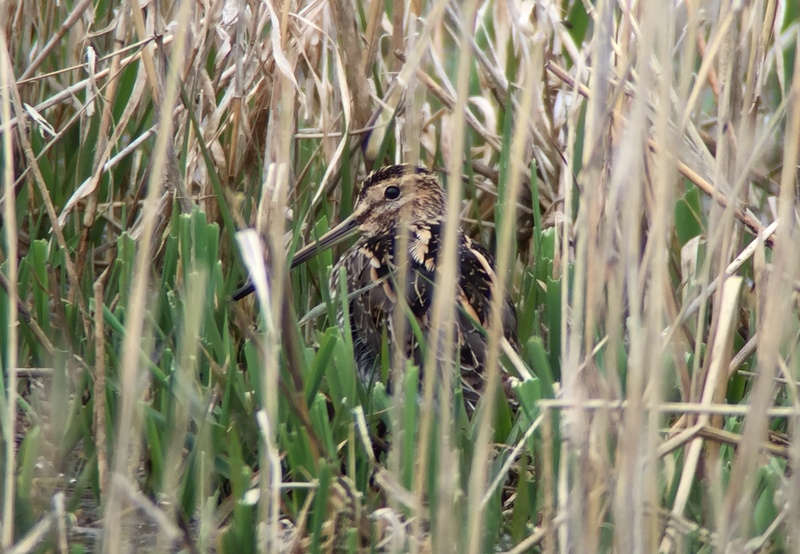 Common Snipe – two were hiding in the reeds in front of Fen Hide
Common Snipe – two were hiding in the reeds in front of Fen Hide
There are so many places for Snipe of any variety to hide here, and even the two which were initially in view eventually flew off and dropped back into the reeds out of sight. Two Coot decided to have a fight out on the water, leaning back and flapping their feet at each other, with two others in close attendance. A Chinese Water Deer was picking quietly around at the edge of the reeds.
We decided to carry on down to the river bank and make our way along to Tower Hide. There has been a Penduline Tit around the reserve for almost a month now, but it seems to have been seen or even just heard on only 3-4 occasions in all that time. It had been reported again early this morning, but had apparently flown over the river at that point. We scanned the heads of reedmace around the edges of the reedbed as we walked along, but we didn’t hold out much hope of coming across it given the history of its appearances.
We were almost at Tower Hide and had pretty much given up when we heard the Penduline Tit call twice, a rather thin, drawn out ‘tseeeu’. Unfortunately we were in just the spot where the trees are thickest between the path and the reeds and we simply couldn’t see through to where the call was coming from. It seemed to have stopped calling now, but we made our way the short distance further to Tower Hide and from the end window there we could look back across the reeds the other side of the trees. There was lots of reedmace down there, but no sign of the Penduline Tit. We waited a while to see if it might reappear, entertained by the local Marsh Harriers displaying over the reeds, but there was no further sight or sound of it.
As we walked back along the river bank, a Treecreeper flew past us and started working its way up the trunk of a nearby tree. There had been a few Chiffchaffs singing this morning apparently, although they had gone quiet now, but we found one feeding in the top of a willow. As we made our way back along Sandy Wall, a Marsh Tit was singing on the edge of the wood and we saw it flitting around in an oak.
We still had one more place we wanted to visit. There has been a Rough-legged Buzzard around Haddiscoe Island over the winter and it had been reported again in the last couple of days. We drove round to one of the places from which it is possible to look over the site and we were just getting into position when we spotted a bird flying away from us, low over the grass, flashing a white tail – the Rough-legged Buzzard. It perched briefly on a gatepost, before flying off even further and disappearing out of view.
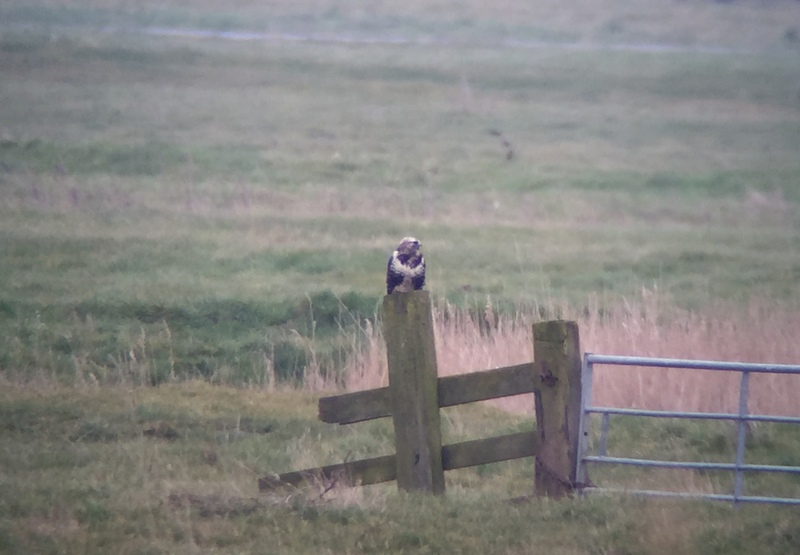 Rough-legged Buzzard – perched briefly on a gatepost
Rough-legged Buzzard – perched briefly on a gatepost
We walked round to where we could get a different angle across the grazing marshes. There were several Common Buzzards of various shades in view, on gateposts or standing around on the ground. One in particular was strikingly white underneath. Everywhere we looked there were also Chinese Water Deer out on the grass.
We had hoped we might get another look at the Rough-legged Buzzard, but just when we least expected it it flew back in across the grass in front of us, landing briefly on another post behind the reeds. When it took off again, it started to hover, flashing its mostly white tail with a couple of black bands towards the tip. It hung there in the air for ages, allowing us to get a great look at it, before it turned and flew back out to the gatepost it had been on earlier.
 Rough-legged Buzzard – hovered close by, flashing its mostly white tail
Rough-legged Buzzard – hovered close by, flashing its mostly white tail
There several enormous flocks of Starlings out in the grass – we could see them occasionally fly up and move across. At one point a male Marsh Harrier had a go at them, dipping down into the group and scattering them, before flying off. The Starlings all immediately resumed what they had been doing. Then suddenly they all took to the air and the flock started to make amazing shifting shapes as they twisted and turned. A few seconds later and we could see why as a Peregrine stooped down through the murmuration, splitting it instantaneously into two.
The Peregrine turned and climbed through the flock before stooping again. This time a single Starling stupidly split off and started flying towards us. The Peregrine set off after it and was immediately joined by a Marsh Harrier, the two of them taking turns to have a go at the poor Starling. It looked like it was certainly a goner until it dropped sharply into a small patch of reeds. The Peregrine immediately lost interest, but the Marsh Harrier tried a couple of times to continue the chase, dropping down as if it was going to land into the reeds.
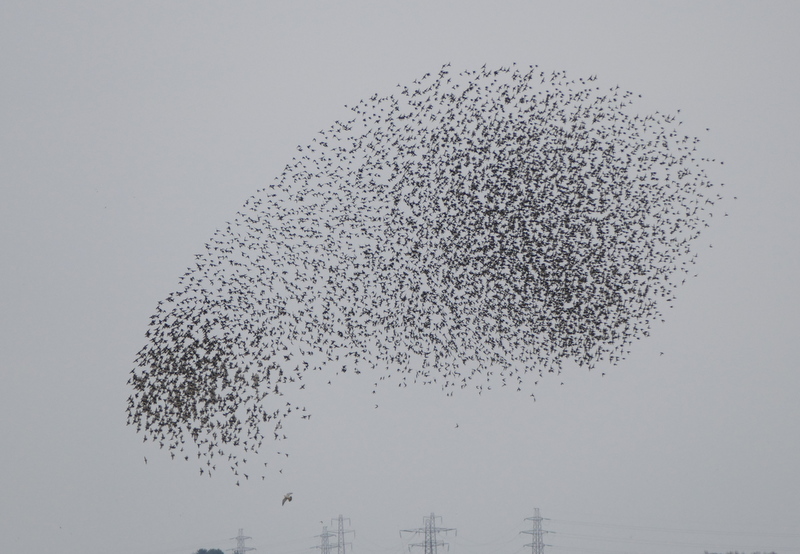 Starlings – pursued by Peregrine (at bottom of flock here)
Starlings – pursued by Peregrine (at bottom of flock here)
The flocks of Starlings had now disappeared and the Peregrine landed on a gatepost out in the grass where it perched looking round for several minutes. Then it took off and flew away from us, climbing high up, over towards Breydon Water. It had gone some way before we could see why, as the Starling murmuration appeared again from behind a bank, way off in the distance. The Peregrine began a shallow dive, powering down hard, towards the Starlings again, scything through the flock once more.
We watched the Peregrine for a while, attacking first one flock. Then, when it had scattered, flying up high and back across to find another group to stoop at. It was great stuff, all action, even if the Peregrine did look as if it wasn’t going to get any supper. Eventually we lost sight of it and a look at the time confirmed we would have to call it a day. Still it was a great way to end.
















